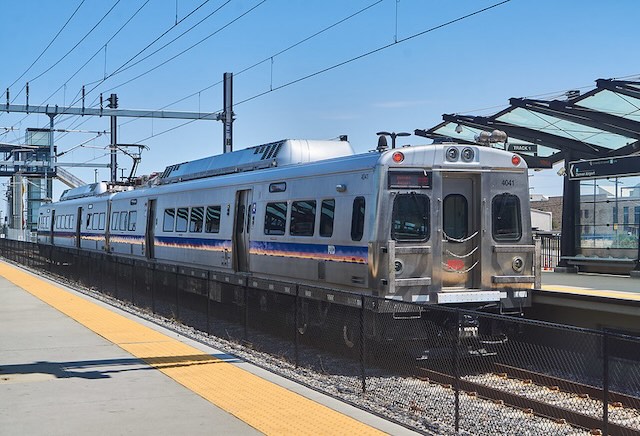In 2004, Denver’s Regional Transit District persuaded the region’s voters to support a sales tax increase to pay for six new rail lines that together would cost about $3.5 billion to build. The agency claimed to be surprised when costs doubled soon after the election. Since then, the $7 billion RTD has spent on rail capital improvements was only enough to build five lines, while the sixth line, which was supposed to connect Longmont and Boulder with downtown Denver, remains unbuilt.
A Denver commuter train connecting the airport with downtown. Photo by Jarrett Stewart.
While all of the rail lines were idiotic, there were good reasons to delete the Longmont line. First, the Boulder part of the line was duplicated by a bus-rapid transit line that has probably been the most successful of the projects funded by the 2004 tax increase. Second, RTD’s own analysis found that the line to Longmont would be so expensive and carry so few passengers that the cost of carrying one rider would be more than $60 compared with under $10 for most other FasTracks lines and no more than $22 for any other line. The line was projected to cost a third as much as all of the other lines put together yet carry only 7 percent as many passengers.
Naturally, the decision to put off building this line rankled politicians from Longmont and Boulder, who believe they were promised a rail line so therefore they should get one no matter what the cost. Most recently that includes Colorado’s Governor Jared Polis, a Boulder resident who complains that he is stuck in traffic with all the other peons when he goes to the capital and that he should have a multi-billion-dollar train just for him. Apparently, having a bus-rapid transit line that is faster than the train would have been and never gets stuck in traffic because it has its own HOT lanes isn’t good enough.
In response to pressure from Polis and other politicians, RTD has issued a so-called feasibility study for a stripped-down plan to run two commuter trains a day each way on existing BNSF tracks instead of the 50 to 60 trains per day each way on brand-new dedicated tracks that were called for in the original proposal. The study estimates the line would carry 1,100 riders per day, compared to 8,600-10,100 per day for the original proposal. RTD collected an average of $2.52 per commuter-rail rider in 2022, so it is likely to collect less than $1 million a year in fares from the Longmont line.
I call this a “so-called” feasibility study because it never says how it defines “feasible” or shows that its plan meets such criteria. The study estimates that operating the train will cost $12 million to $17 million a year, far more than likely revenues of less than $1 million a year. But, as we all know, when it comes to transit, economic efficiency has nothing to do with “feasibility.” Instead, the only question is whether transit agencies can persuade politicians to support their expensive crackpot schemes.
In short, the proposal would cost 40 percent more and carry 87 percent fewer riders than originally projected in 2004. According to an article in yesterday’s Denver Gazette, even many transit supporters question the wisdom of this scheme.
If RTD cared about transportation, it would instead start a BRT line from Longmont to downtown Denver that would go on Interstate 25. While RTD’s feasibility study estimates the train would average 38 miles per hour between Longmont and downtown Denver, a bus on I-25 could average 55. For a lot less money, buses could run all day instead of just twice a day each way. But of course this train has nothing to do with transportation and everything to do with keeping politicians happy, so RTD — which is seeking a tax increase to help pay for running a transit system that is carrying just 60 percent of pre-pandemic riders — is likely to do it.









ARThomas: Why do we need 6 lane 45 mph arterial collector routes?
Amateurs. In Honolulu we averaged 3,194 riders per day for the first year. O&M was estimated at $94 million, or ~$257k per day to keep the fiasco running, and that has been “estimated” to increase to over $150 million ($411k per day) by 2030, even before the truncated route to the imaginary “civic center” is completed in 2031. Total revenue for the first year was $611k, or roughly $.53 revenue per rider, and a fare box recovery ratio of .66%, vs their stated goal of 25-30%.